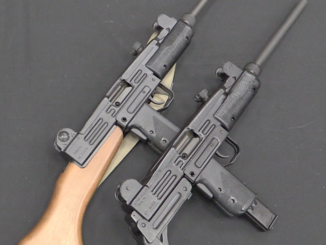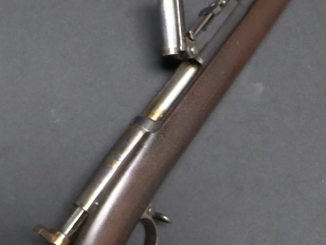The Thompson submachine gun struggled to find a market when it was originally produced, with the first batch of 15,000 Colt-made guns not finally all selling until the late 1930s. By that time, the clouds of war were gathering, and demand for submachine guns finally began to really grow. The US military had some Thompsons, and the British began buying as many as they could. The US wanted to increase production, and that meant simplifying the gun, both to reduce cost and to increase manufacturing efficiency. Talks to this end began in late 1941, and by February 1942 the engineers at Savage had a prototype of what would become the M1 Thompson.
This new version simplified almost every element of the gun, but most significantly it replaced the 3-piece Blish lock bolt with a solid one-piece affair that just worked as a normal blowback action. Unnecessary elements like the vertical front grip, Cutt’s compensator, quick-detach stock, and fancy contoured selector levers were discarded. The adjustable Lyman rear sight was replaced by a single metal tab with an aperture (quickly given a set of protective wings though, as the tab alone proved too fragile). The recoil guide rod was simplified, the oiling pads inside the receiver removed, and a simpler recoil buffer designed. The capability to use drum magazines was also discarded, and a new 30-round box magazine took their place.
The M1 was adopted in the spring of 1942, and July saw the first major delivery, of 48,000 guns. Simplifiecation work continued, however, and by the end of October a yet-simpler M1A1 pattern was adopted. This model replaced the hammer mechanism with a fixed firing pin. As a result, M1 production lasted only about 5 months. A total of 285,480 M1 Thompsons were made, but most of these were retrofitted to M1A1 configuration by simply swapping in the simpler new bolt. Finding intact M1 configuration guns is rather unusual today as a result.




How did Auto Ordinance guns come to have a faster rate of fire? If the difference was accidental (spring temper or what not) wouldn’t there be a simple fix?
coil springs are not usually tempered.
They’re wound from wire that is left in the work hardened state after being drawn.
all steels are of roughly the same stiffness, regardless of their state of heat treatment or alloying content.
having eliminated those two possibilities
we’re left with, wire thickness,
spring length and number of coils (more coils for the same free length, gives a softer spring)
and possibly the thickness of the felt in the buffer, as a harder bounce at the end of the bolt travel will speed its return.
Why they never managed to make upper from stamped steel, that would have been a worthwile simplification.
Once they’d decided to go to stamping, it made no sense to remain with a design that was meant to be machined out of billet. If you’re going to go stamped, a different design was going to be needed, anyway, so why not take advantage of it and totally redo the entire weapon?
That is true!
But, why not strike a balance between ugly grease gun and nice looking Tommy gun.
I wonder if even the vietnam war jungle shop knockoffs did that at least in some examples, however idk if they had adequate stamping technology.
Procuring Body and Trigger Action Casing and Stock Butt Slide from Light Alloy Die Casting/Hiduminum 53C was entertained according to A September 1940 dated document from the Springfield Armory with some proposals and specifications for making Thompson parts from aluminum. (Courtesy of the Royal Armouries Library, Leeds, UK) and During 1940, Savage Arms decided to produce a number of prototype Thompson receivers and trigger frames from heat treated aluminum forgings. The material was lighter and could be machined much faster than steel.
See https://smallarmsreview.com/the-aluminum-thompson-smg/ for details
I remember you mentioned this few years before, but at that time I think Small Arms Review article was unavailable, not digitized from magazine to internet, so this is still good addition.
I can perfectly understand why the bolt simplification of the M1A1 was adopted. But I cannot see any benefit in retrofitting the simplified bolt onto M1 models. The M1 bolt was already much simplified over the M1928, and worked, so unless it was broken in some way (which seems unlikely) why bother changing it?
I also wonder about production figures. I had it in mind that about a million Thompsons were produced. If Savage were turning out a minimum of 85,000 a month from mid 1942, then a million would have been made in about a year. Can this be right? When did Thompson production stop?
Logistics. It’s just simpler to only have one type of part in the supply chain for one type of equipment.
In the Vietnam War, most Bell UH-1B helicopters in service after 1965 actually had UH-1C tailbooms. (They can be spotted in photos by the greater chord of the vertical stabilizer that supports the tail rotor, and the upper surface of the horizontal stabilizer, minus the reinforcing “ridge” of the -1B stabilizer.)
The reason? Bell stopped building UH-1Bs when the -1C came online in early 1965, so when a -1B in service needed tailboom repairs or replacement due to wear, damage or etc., it was simpler to just bolt on a -1C tail.
If you ask why they do anything a certain way in the military, the answer is almost always “logistics”.
cheers
eon
Eon:
I don’t see it. The bolt on an M1 looks pretty bombproof to me. I can see it being switched for an M1A1 bolt if it is damaged, otherwise there is no reason to change it.
I suspect the whole quasi “hammer” affair maybe did not worked as well and reliable as having only fixed firing pin.
It is possible to imagine how in such interaction firing pin energy could be in some degree lost.
I don’t know the actual reasons, but I can speculate
firing pins are not always the most durable part of a gun…
and
small parts are very attractive to leprechauns and other supernatural beings, who quickly grab them and hide them away when someone drops them…